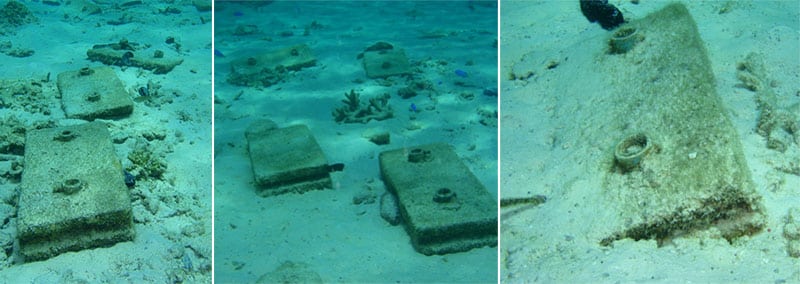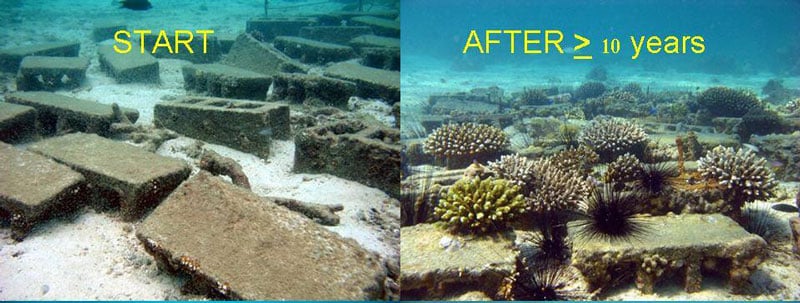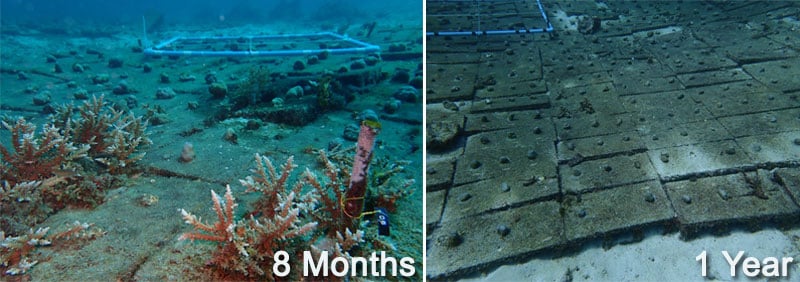Are breeze blocks and effective tool in coral reef restoration? In our previous articles we have always said no, but as this technique continues to be used and even expanded in many reef restoration projects in places like Thailand, we wanted to take a closer a look at it and talk with some other experts to see what they think. The technique is quite simple, and the materials are cheap and readily available, which are both very important qualities for the large-scale implementation of any coral restoration method, and thus deserves a closer look.
How the breeze block technique is used
Breeze blocks, also known as cinder blocks, are a low density, aerated concrete product designed for non-load bearing applications in home and building construction. They are designed to be light, easy to cut to size, and cheap. Each block weighs just 8 kg or less, and costs between 3-6 Thai Baht ($0.01-0.02 USD). Generally, when used in coral restoration, small fragments of coral are affixed directly to the blocks using epoxy or cement. In more elaborate projects, holes are drilled or punched into the block and the coral is glued into it, or in some cases PVC or steel is first affixed, and then the coral fragments. Generally, between 2 and 6 corals are secured to each block, and then the blocks are set down as a sort of pavement at the restoration site. The technique is quick and cheap, and is attractive to reef managers that are looking to create large projects in a short amount of time. But, are these types of projects usually successful?
Effectiveness of Breeze blocks in restoration

here at Conservation Diver, we have long been critics of this technique for several reasons, mainly that the blocks are too light to provide an effective substrate for long-term coral survival, and that they are unattractive, and tend to either move around in the waves or sink beneath the sands. The blocks, which weigh only 8 kg on land, lose about 40% of their weight in water, and due to their high surface area and low density make them unstable for long-term coral growth. We first witnessed this back in 2006, with the complete destruction of such a project on Koh Tao that was put down in 2005 by the Koh Tao Dive Operators Club in the vicinity of Sai Nuan at a depth of approximately 3-4 meters. After only 1 year, none of the corals on the blocks had survived.
The second reason why we were critical of this technique is that the resulting pavement-like reef that is created does not mimic a natural reef in structural complexity or 3-dimesnional relief. The resulting reef has little to no vertical profile, does not provide diverse habitat for symbiotic reef fishes, and is prone to smothering by sediment and moving sands. Furthermore, depending on the manufacturer, these blocks often contain a high percentage of fly-ash, which depending on the source, can contain dangerous levels of heavy metals or other toxic contaminants whihc limit coral growth or can even contribute to coral disease.
Even though these were our experiences and our assumptions, we could not effectively evaluate this technique as there are very few scientific reports available on the successes or failures of the method, and we do not imply this technique in any of our programs around the world. Online searches through the scientific literature, grey literature, and google images yielded many articles and pictures of the reefs immediately after deployment, but no follow-up reports could be found, which we felt was a major red flag. If people were only posting their nice pictures of the projects immediately after deployment but not years later, then we assumed they all must have failed, just like the ones we were familiar with.
Positive experiences with the Breeze blocks in restoration

Although there are very few scientific reviews of the technique, the ones we were able to find showed a different story to the one we had been telling our students for over a decade. The first example comes from Maiton Island, off of Phuket Island in Thailand, in a project done by Dr. Nalinee Thongtham, and was published as a case study in the CCRES Reef Restoration Manual. The pictures of the project show great success after more than 10 years, with the blocks well covered in small corals from a variety of genera and species. However, this project differed from many of the ‘mainstream’ projects we evaluated in that the blocks used were the largest size available, and no fragments were transplanted to them, they were just left to receive coral recruits naturally. When reached for comment, Dr. Thongtham said “I just provided hard substrate for natural coral larvae to attach and grow naturally. Coral transplantation is not necessary in this area. . .There is no standard restoration method that is effective for all reefs. Different restoration methods can be used and applied to different environmental conditions. For example, providing hard substrate for coral larvae is a suitable method in areas where coral larvae are available but there is no hard substrate for them to grow.”

The second published review of this technique which we found was in a 2012 paper by Young et al. and looked at the technique’s application for restoring branching Acropora in the Caribbean. Not much detail is given on the depth, location, or details of the method used, but their findings regarding the use of cinder blocks was considered overall positive, even though in some cases 12-56% mortality was experienced in the first month, and one project experienced 80% mortality following a hurricane. They reviewed 7 projects in Florida which used cement blocks, and the authors’ conclusion was that the coral fragments transplanted had “positive growth rates, low mortality, and were capable of sexual reproduction.” The problems they identified were “accumulation of sediment and macroalgae, susceptible to storm damage, and epoxy failure.”
We also spoke with Mr. Niphon Phongsuwan, Specialist on Marine and Coastal Ecosystem Research for the Thailand Department of Marine and Coastal Resources, who has over 20 years of experience with coral restoration. He provided photographs of a more ‘traditional’ cement block project on Koh Racha. The pictures show a high survival rate of the fragments, and a low incidence of sedimentation or movement of the blocks. Mr. Niphon stated that when using ‘the breeze blocks, the place must be deep enough (I recommend deeper than 5 m and never work at the wave exposed site or strong current site). At [Koh] Racha the depth is about 8m so the blocks have no impact from waves.”

Concerns about breeze blocks for coral restoration
We also talked to some experts who opposed the use of the breeze blocks, for several reasons. When we contacted Dr. James True who has extensive experience with coral restoration in Australia, Hong Kong, and Thailand, he said “My feeling is that (of the many potential concrete-based solutions) breeze blocks are the least effective substrate alternative. Even threaded together by lengths of rebar, they are prone to displacement, shattering & burial by wave action. Railway ties, molded modules, pipe clusters, even power poles or the typical fisheries hollow box elements are all more stable and provide better long-term alternative substrate. As mats, they provide no vertical relief, no complexity and no hydrological advantage over sand.”
When we asked Spencer Arnold, the director and designer of artificial reefs for Conservation Diver, he said that he preferred purpose-built structures which provide more complexity and act as a better habitat for reef organisms, and also are more attractive to divers. He went on to state that “from an aesthetic perspective, cinder blocks as an artificial reef design hold all the appeal of a parking lot. If you like parking lots, you’ll love a cinder block reefs.”

The method of coral transplantation and propagation also plays a major role in the long-term success of such projects, and is something we are always highly cognizant of in our restoration efforts. Previously, we have strongly spoken out against programs that rely on asexual propagation and the use of donor corals for the reduction they cause in genetic variability and thus the resilience of the restored reefs. This was also mentioned by Dr. Thongtham, who stared that “genetic diversity is a major key to sustainability of coral reef restoration. As shown from our study during a mass bleaching in 2010, high mortality of transplanted corals occurred in areas where mother colonies were used while in areas where there were natural recruits, most of the coral recovered very well.” Indicating that it may not be that the technique is inherently good or bad, but like most things, that it all depends on how it is applied.
Conclusions
For over a decade we strongly opposed this technique for coral restoration, and instead focused our efforts on using stronger, heavier, and more structurally diverse artificial substrates when replacing lost structure or expanding reefs through our global projects. However, that may have been a slightly draconian view to adopt, as indicated by the limited sucess and positive experiences of others while using this technique. However, in saying that, we must stress the caveat that this technique should be used carefully, as it will not be successful in all applications. Based on the case studies and our experiences, we would recommend only using this technique if the following consideration are met:
- The blocks should only be used in areas where there is little to no wave action or likelihood of large storms (ie sheltered bays, deep areas), and where sedimentation is not a major issue.
- The blocks should ideally be used in conjunction with other structures which provide complexity and habitat to fishes and other reef organisms, many of which are symbiotic and essential to healthy coral growth and reef development.
- Care should be taken when removing corals from the sea for attachment, and methods which do not require removing the corals from the water are generally preferred.
- If using prefabricated breeze blocks and other types of low density or aerated concrete, the largest size should be selected, and efforts should be made to consolidate them or lock them in place to reduce storm related mortality.
- Coral propagation (asexual fragmentation) and the use of donor corals is never advised, as the long-term genetic effects lead to reduced resilience and survival through mechanisms such as genetic bottlenecking, inbreeding depressions, and reduced reproductive success.
In our programs, we will continue to use other techniques, and see very little reason to use cinder blocks when so many better materials and designs are readily available. However, after talking with more experts we recognize that there is a place for these techniques, and for programs using unskilled volunteers and working with limited budgets this technique can be useful in building community awareness, involving a wide range of stakeholders.
